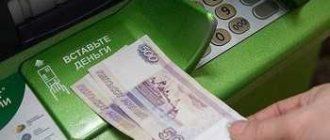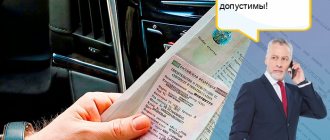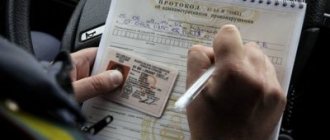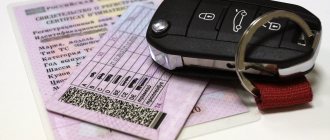| Question | Answer |
| Is it the inspector's responsibility to present his official ID? | A driver or pedestrian stopped by a traffic police officer has the right to demand that the inspector present an official document. The employee must show it by unfolding it, but is not obliged to hand it over to third parties. |
| Why might a vehicle driver need data from an inspector’s official ID? |
|
| What is the procedure for communication between the inspector and the vehicle driver? | The inspector must communicate with the individual in a formal, polite manner. He must remain tactful and be objective. Addressing “You” is acceptable. The requirements and comments voiced by the inspector must be clear, convincing and unambiguous. The employee must show calm and restraint. |
How to properly cross the road for a pedestrian according to traffic rules - are there fines for violations?
When stopping a vehicle, the traffic police inspector is obliged to present the service identification card in expanded form at the request of the driver - a road user.
Such actions will help protect against scammers who often take advantage of the legal illiteracy of the country's population.
What you should pay attention to will be discussed in this article.
Appearance of the ID
A traffic police certificate is an official document that allows you to identify the identity of the inspector, his position and rank, and confirm his affiliation with the Ministry of Internal Affairs, in particular a certain territorial body (unit).
Issued upon appointment (admission, enrollment, transfer, assignment of title), change in personal information and the name of a structural unit, expiration of the validity period, as well as to replace a stolen, lost or damaged document.
In accordance with the order of the Ministry of Internal Affairs No. 1234, the ID of an employee of the State Traffic Inspectorate can only be used in the performance of their duties and only for official purposes.
It is a “crust” of dark red or burgundy color, on the title page of which there is the inscription “Ministry of Internal Affairs of Russia”; the republic, region, territory within the state to which the traffic police inspector belongs can also be indicated.
There is no time for bureaucracy in the traffic police - a power of attorney will help!
You can verify the authenticity of your service ID by opening it. The spread contains 2 pages. On the first (left side) there is a photograph of a traffic police officer on a white background, the right corner of which is marked with the seal of the structure. Under the photo you can see the inspector’s personal number (one letter and several numbers). Next to the photo is the coat of arms of the Russian Federation, under which “Ministry of Internal Affairs of Russia” is written in red letters. Below is the service region code and document number. The following is the date until which the certificate is valid.
On the second page (right side) there is the inscription “Department of the Ministry of Internal Affairs of Russia for (name of region and locality).” Below is the inscription “Service ID with the letter designation of the territorial unit of service and the document number.” Next, there is a record of the employee’s rank, his full name, and position. Under the personal information there is information about the right to own and use service weapons. The last line of the document is the signature and full name of the chief or his deputy of the territorial body of the Ministry of Internal Affairs and the date of issue of the document.
I no longer like the car - is it possible to return it to the dealership or to a private seller?
The authenticity of the official “crust” is verified by the presence of a wet seal, which represents the state emblem in two circles of different sizes and has the inscription Ministry of Internal Affairs of the Russian Federation. The diameter of the seal is 25 mm, which is regulated by state standards.
Stamps
Important elements are seals, there should be two of them:
- on the picture;
- on the second page, in the lower left corner.
The seals display the country's coat of arms, which is located inside two circles. Please note that the following inscription is visible along the edge: “Ministry of Internal Affairs of the Russian Federation.” The print diameter is 2.5 cm.
If at least one of the above points does not match, then the driver has a good reason to doubt the authenticity of the information provided, and, accordingly, that the vehicle was stopped by a real employee of the Ministry of Internal Affairs.
Does the traffic police officer have to present a certificate?
All rights and obligations of employees of the Ministry of Internal Affairs are enshrined in the Federal Law “On Police”. The actions of traffic police officers are also regulated by Order No. 664, according to which an inspector who is on duty during a stop of a vehicle or a pedestrian is obliged to present his official identification card in an open form, without letting go of his hands.
At the same time, communication with road users must be polite and tactful, all judgments must be objective.
The police officer must address the driver as “you”, and state all requirements in an accessible form, excluding double interpretation.
What to do if he refuses
If the traffic police inspector refuses to present his official identification, the driver should have suspicions about the legality of the actions of the person who stopped the vehicle. In this case, you must notify the traffic police officer about the call to check your data. You can use several options and call:
- to the Ministry of Internal Affairs hotline using a single number - 102;
- to the emergency service – 112;
- helpline, which is located on the patrol car.
Protocol on an administrative offense - how can a driver protect his rights?
After the operator’s response, it is necessary to indicate that outside the traffic police post, a citizen who introduced himself (indicate rank, position and full name), wearing a traffic police uniform, stopped the car and refused to present his ID as a State Traffic Inspectorate inspector. Such actions will help determine whether a citizen is truly a police officer.
Rules for studying the ID
The traffic police officer's service ID must be examined:
- in order to verify the legality of the actions of a person representing the structure of the Ministry of Internal Affairs;
- to obtain information about the unit to which a complaint can be sent in case of violation of the driver’s rights and duties by the inspector;
- to verify the information specified in the document and the protocol;
- to apply if the employee has not returned the license that he checked.
In order to make sure that the traffic police inspector, who is performing official actions legally, is in front of the driver, the driver should be asked to show his ID. To study the information, you must ask to open the document.
Important! The State Traffic Inspectorate employee is obliged to keep the “crust” open until the motorist has studied all the information. If necessary (in case of illegal actions of the policeman), the driver has the right to rewrite the document data.
How to properly study a traffic police inspector's license
If the service employee does not present the document himself, you need to ask about this at the beginning of the conversation, before showing him your own car license. In case of refusal, you should remind him of paragraph 2.4 of the traffic rules:
Persons who have the right to stop a vehicle are required to present an official identification card upon the driver’s request.
The motorist should:
- wait until the inspector says his name, rank and position, remember them;
- ask to open the document so that its entire internal part is visible;
- demand that the ID be presented not just for a second, formally, but to be open for a sufficient time;
- rewrite important data from it;
- do not try to take the document in your hands; employees of the Ministry of Internal Affairs are prohibited from giving it to anyone;
- if it is overdue, call the unit's duty station indicated on board the service vehicle.
When the stopped driver clearly understands that he was stopped not by a traffic police officer, but by a person with a false ID, you need to lock the car doors, drive away from this place to a safe distance and call the police.
If the document is expired
The Federal Law of the Russian Federation “On the Police” states that a service ID allows you to identify the identity of a traffic police inspector, his position, rank, full name and affiliation with a certain structure of the Ministry of Internal Affairs. Also confirms the legal right to own firearms. The legal act does not indicate the validity period of the document. Delay may be due to technical reasons that are beyond the employee’s control, for example, lack of forms.
How to transport oversized cargo - what do traffic regulations say in 2021?
Therefore, if a driver is stopped by a traffic police inspector with an expired license, it is necessary to comply with all his requirements. In order to verify the legality of the actions, you should call the helpline of the Ministry of Internal Affairs, the uniform police number -102 or the rescue service - 112.
What are license tags?
Thanks to open access to information resources, a large number of motorists have become more literate from a legal point of view. Now, when drawing up a protocol, the driver can easily challenge the decision of the traffic police inspector, provoke him into a conflict by filming everything on a recorder or mobile camera, and even record the fact of a bribe, which is punishable by the criminal code.
In order to protect themselves and their colleagues from such conflicts, traffic cops introduced a certain system of marks in the form of dots on the license, briefly describing the essence of the citizen in front of them. Thus, having run into a provocateur or a law-abiding person, the policeman will no longer be at a loss, and will follow the simplest algorithm (offer to pay the fine on the spot, draw up a report on the violator, or simply let him go).
How they are made and why
The marks on a driver's license are a regular puncture (not a through hole) that can be made using any pointed object. More often, such information signs are placed with a pen, since it is always at hand.
But this option has one significant drawback: paste often remains at the puncture site, attracting undue attention from the driver. Therefore, a ballpoint pen is often replaced with a needle, pin, or even a fastening element for a badge. Traffic cops mark their rights solely for their own safety, so as not to get caught for bribes or other violations in the future.
Does a freelancer or vigilante have the right to stop a vehicle and how should the driver behave?
A freelance police officer is a citizen who is not an official of the Ministry of Internal Affairs and has expressed a desire to provide assistance in performing duties on a free and voluntary basis.
In accordance with the law, such persons have the right to participate in ensuring road safety and have the same rights and responsibilities as a traffic police inspector. However, a freelancer must perform all actions under the guidance of the traffic police officer to whom he is assigned.
To maintain order and ensure safety on the road, a certificate of the established form is issued. Otherwise, all actions of a citizen are unlawful.
Traffic police vigilantes are citizens who have expressed a voluntary desire to assist traffic police officers in ensuring public order and safety on the road. To perform the assigned duties, a certificate and badge are issued, as well as a special cape with the appropriate inscription.
I was deceived at a car service center - where can I complain?
The police officer has the right to stop the vehicle and ask for documents for inspection only in close cooperation with the traffic police. The driver is not required to give up his license. In this case, the voluntary person notifies the traffic police inspector, who examines the driver’s license.
Why do you need to require identity documents from traffic police, traffic police, traffic police?
In fact, the organization that monitors compliance with traffic rules and ensures safety on the road is called the State Traffic Safety Inspectorate, and the traffic police is its structural division. It is these abbreviations that can be found on the documents of inspectors, and not “traffic police”. The need to ask service employees for identification exists for:
- Reconciliation of information in the protocol and document. The inspector may make a mistake or deliberately provide incorrect data. And this is already a reason to challenge the punishment imposed by him.
- To determine whether a real inspector is making a claim or a person with fake “credentials” who is not related to the organization. This will help not only save money, but also the driver’s documents, car, and sometimes his life.
- Combating illegal actions of a real traffic police officer. Information from the ID will help to find him if he took and does not give back documents belonging to the driver. Knowing them, it is easy to contact the department where an unscrupulous employee works. The same information in the copy of the protocol that the driver receives in his hands may be written illegibly.
More on AutoLex.Net:
Drivers will be deprived of the opportunity to pay off punishment for an accident









